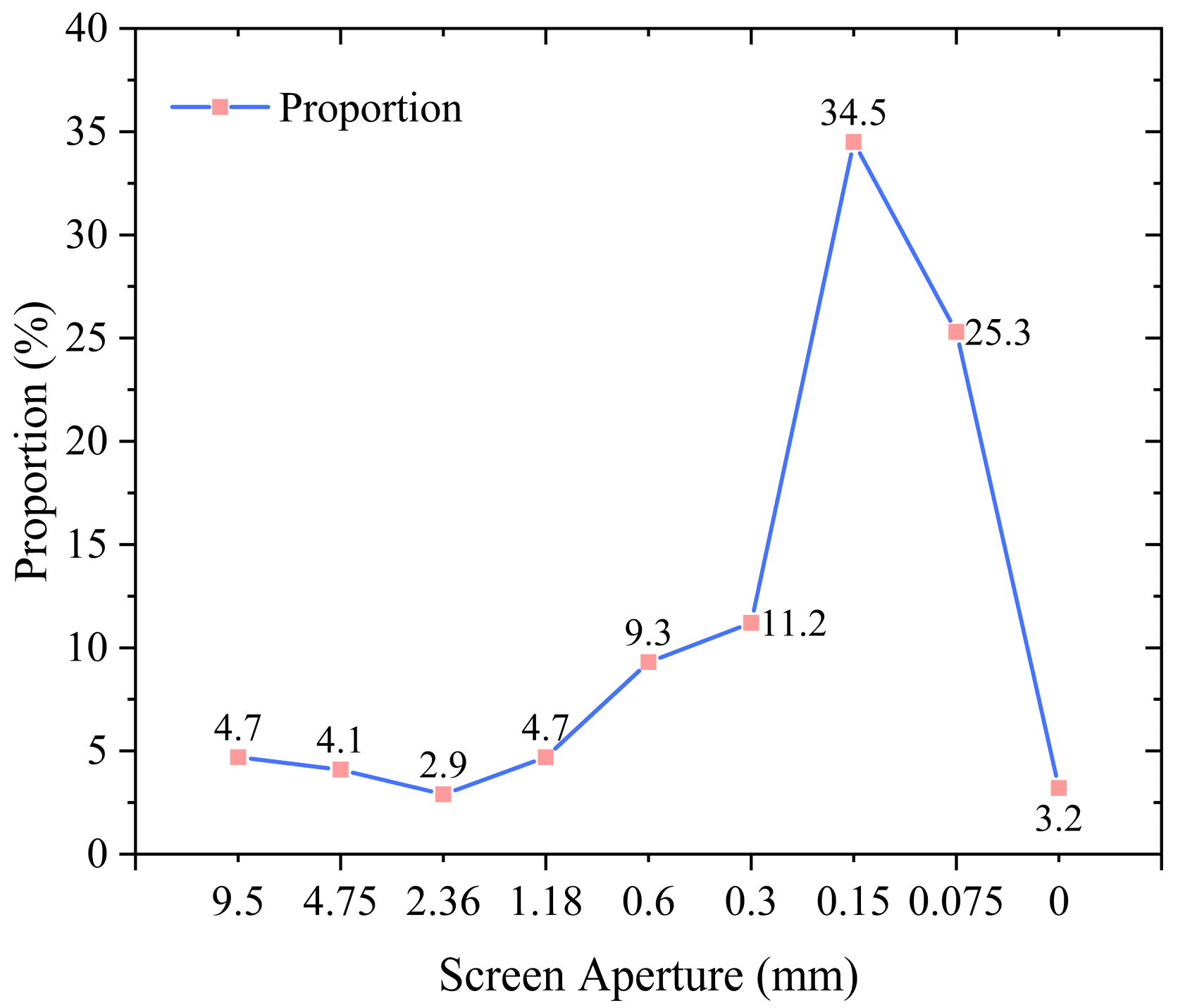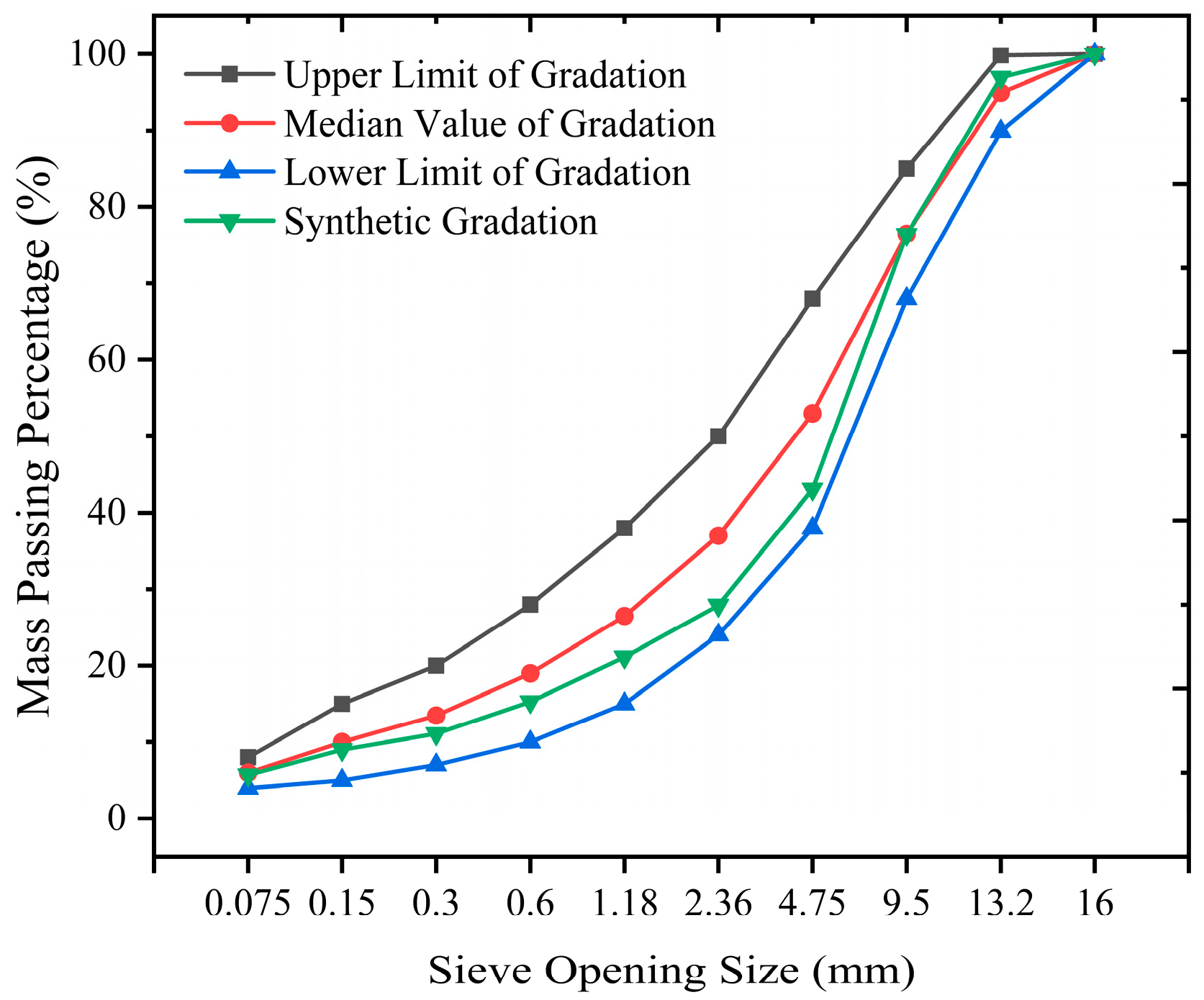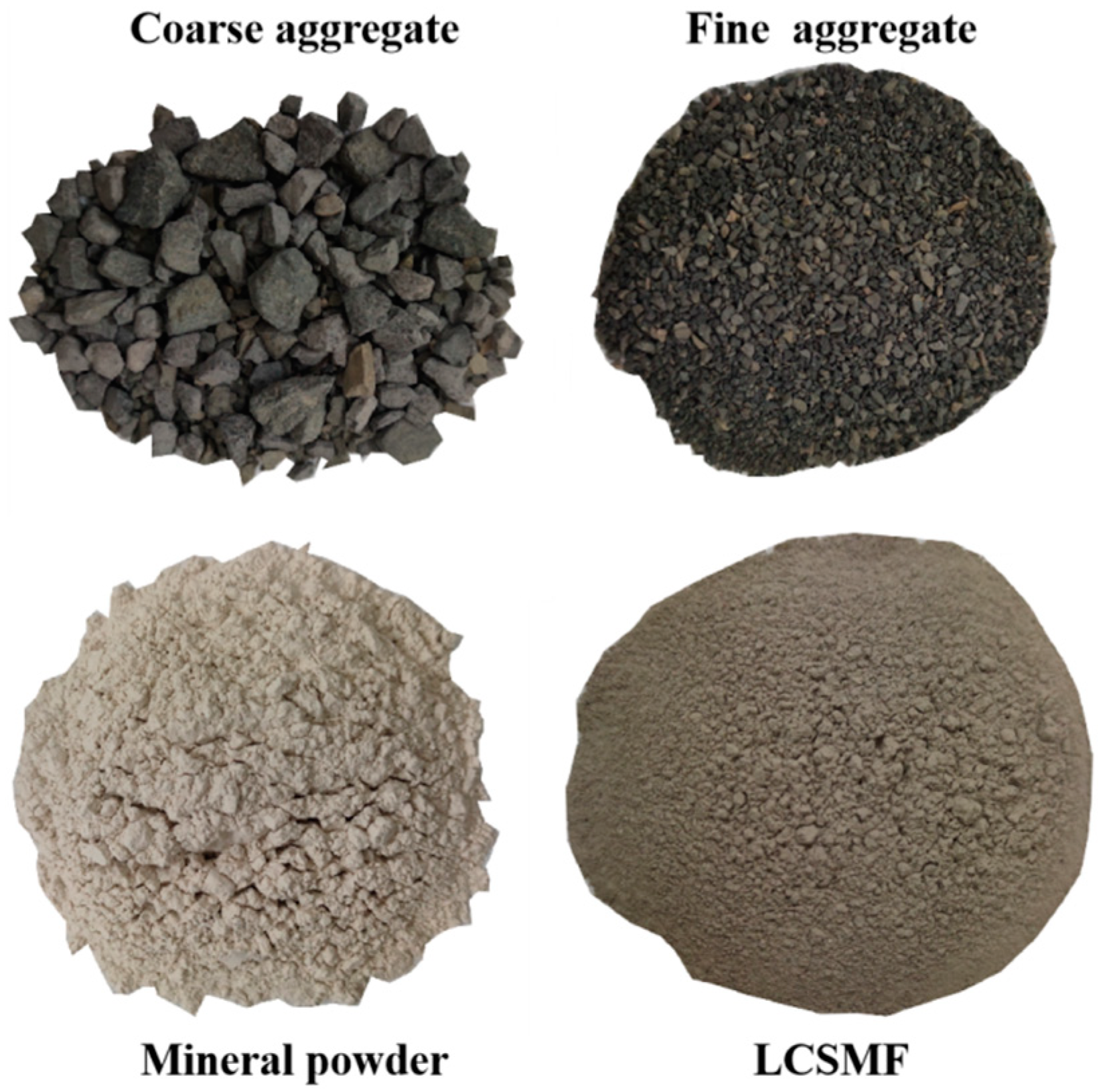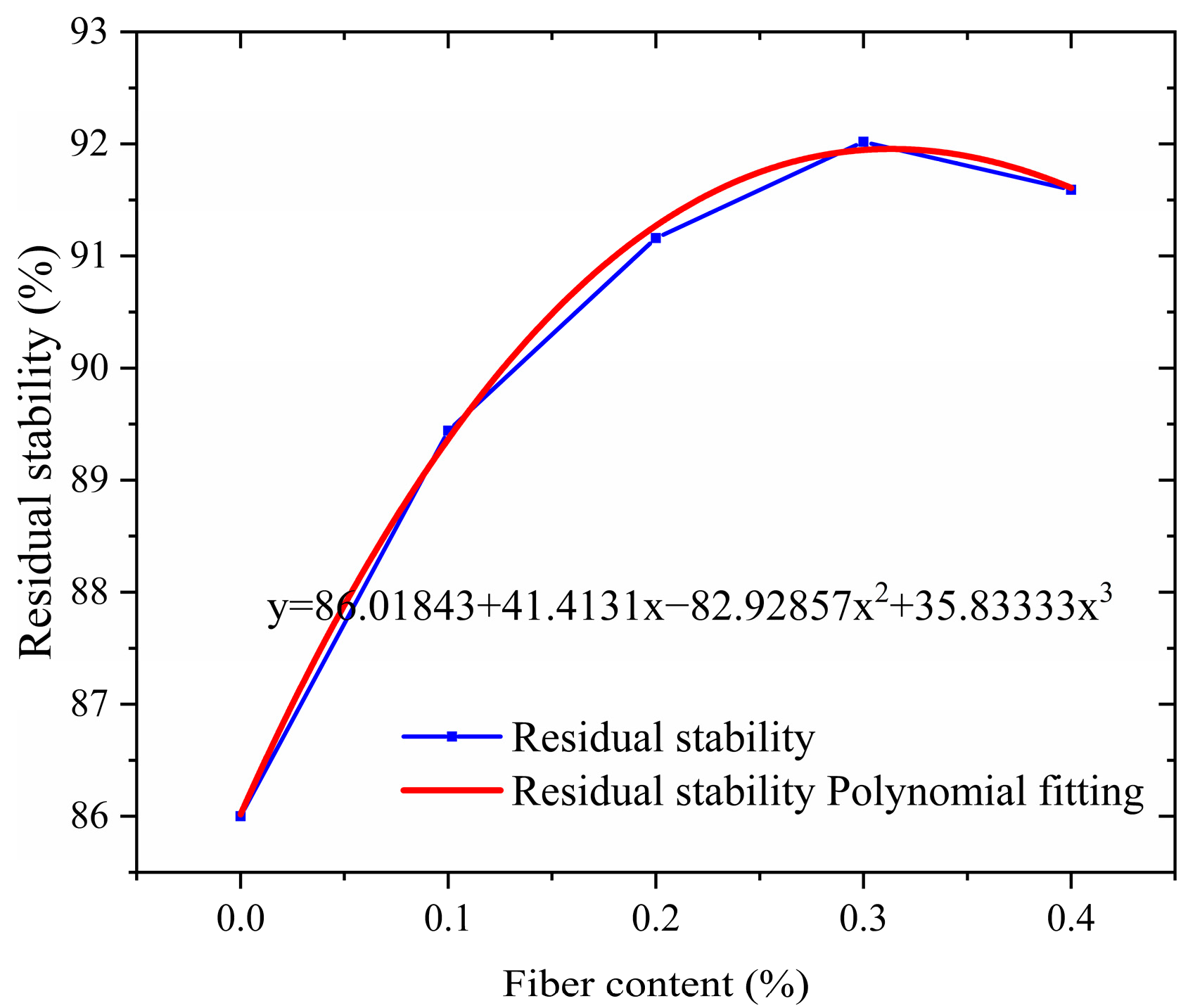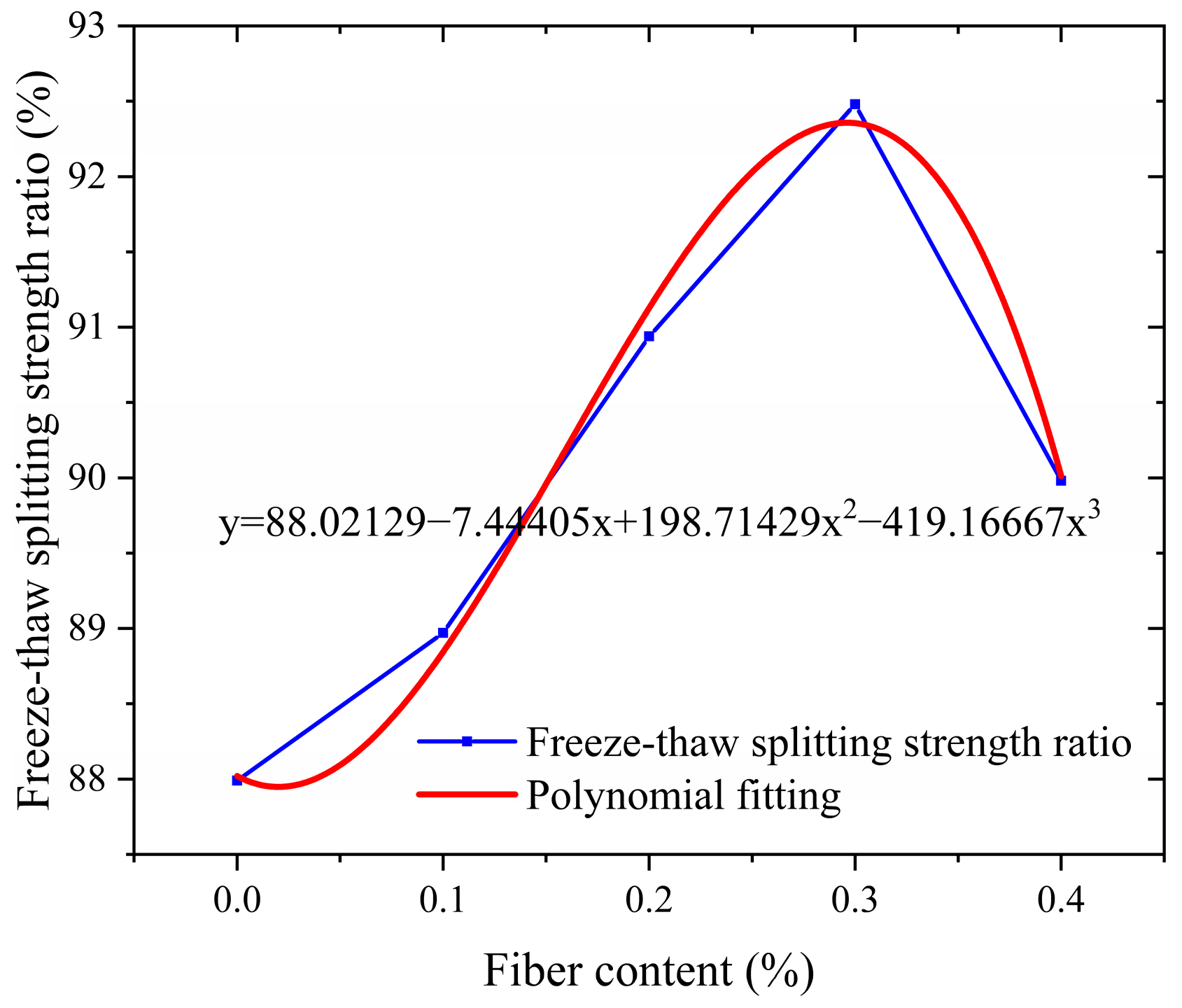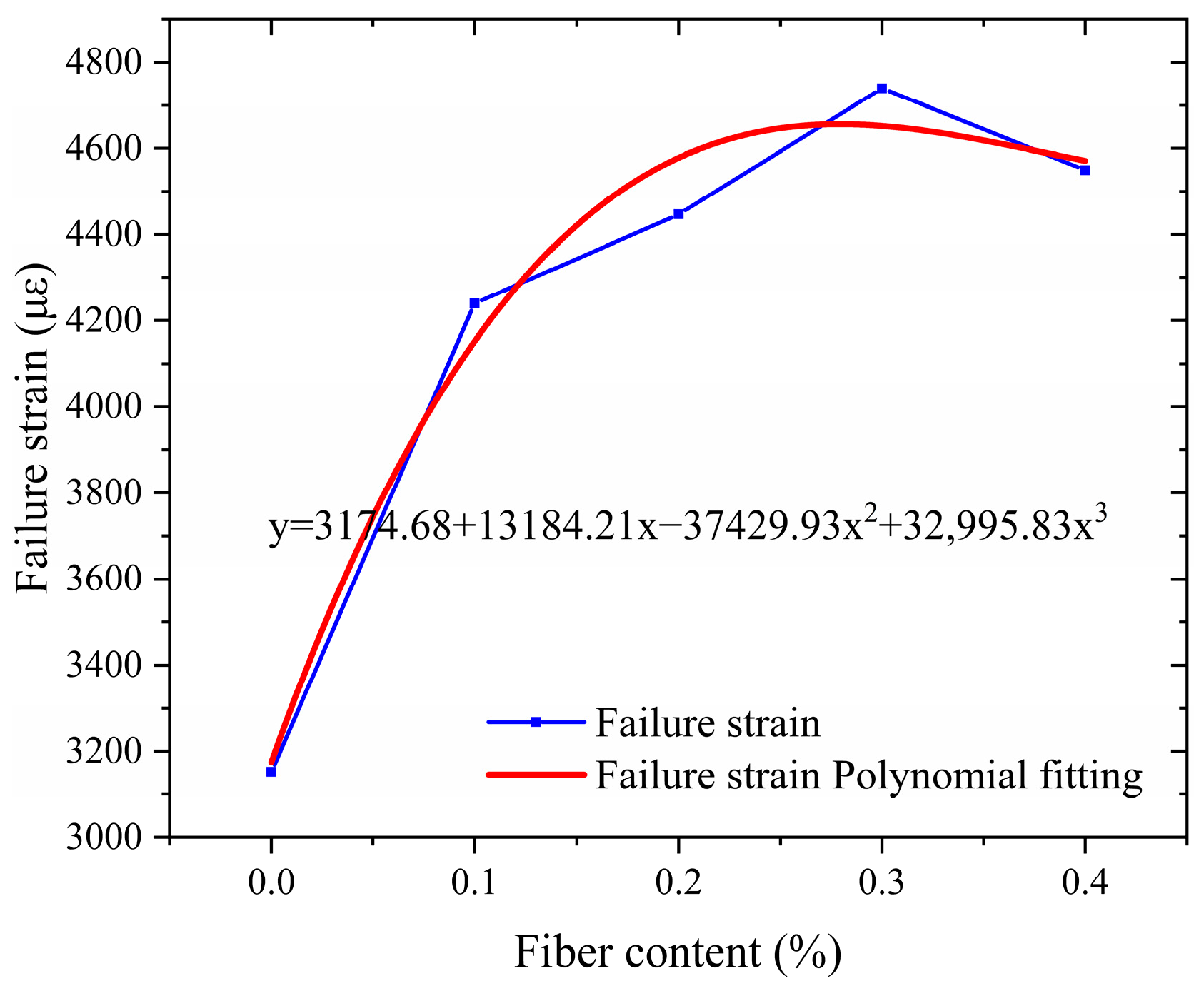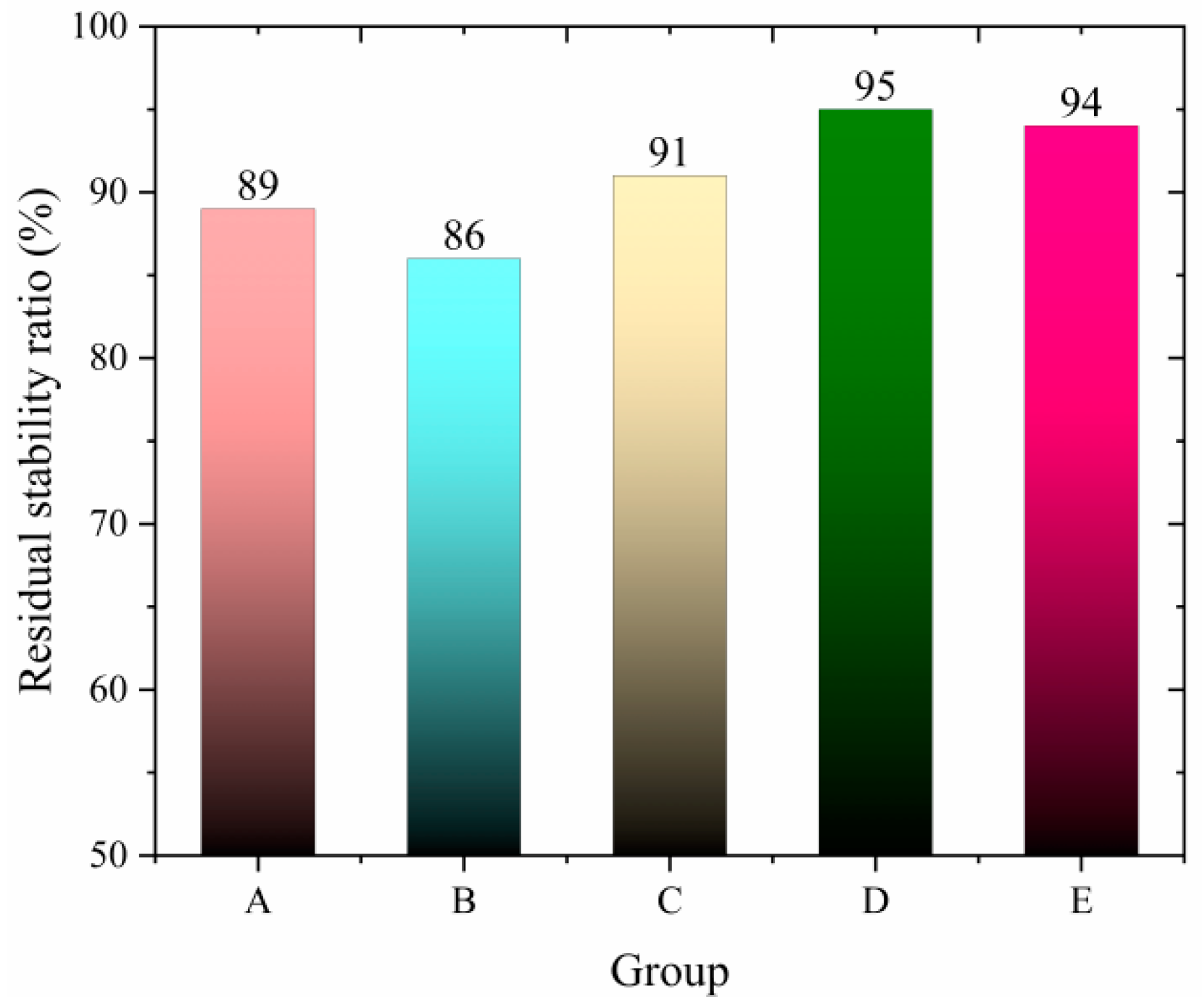2.2.3. Experimental Methods
When fiber materials modify salt-storage asphalt mixture, LCSMF snowmelt filler replaces all mineral powder in the mixture by equal volume in this study, and rWTB content is designed into four kinds of content: 0.1%, 0.2%, 0.3%, and 0.4%. In addition, a group of ordinary asphalt mixture and a group of salt-storage asphalt mixture (LCSMF completely replaces mineral powder) were designed in this study. Because it is difficult to control the uniform length of rWTB when it is broken, fibers in the length range of 0.075–9.5 mm were selected.
Based on the designed groups, conventional pavement performance tests were conducted, including high-temperature rutting tests, low-temperature beam bending tests, water-soaked Marshall stability tests, and freeze–thaw splitting tests for the salt-retaining fiber-reinforced asphalt mixtures. Furthermore, considering that fiber-reinforced and salt-retaining asphalt mixtures exhibit significant limitations in water stability when used in pavement applications, this study aimed to prioritize investigating the water stability and resistance to dynamic water flushing under summer rainfall conditions. To this end, a high-temperature dynamic water flushing system was specifically designed to evaluate the performance of this asphalt mixture.
This study utilized the Asphalt and Asphalt Mixture Test Specifications for Highway Engineering (JTG-E20-2011) [
25], specifically Test Method T0719, to evaluate the high-temperature stability of asphalt mixtures through a rutting test. The test was conducted at 60 °C with a wheel pressure of 0.7 MPa ± 0.05 MPa. The rut depths, denoted as
d1 and
d2, were measured at 45 min (
t1) and 60 min (
t2), respectively, with precision up to 0.01 mm. If excessive deformation occurred such that the rut depth reached 25 mm before the 60 min mark, the time at which the 25 mm deformation (
d2) was achieved was recorded as
t2, and the deformation at
t1 (15 min prior to
t2) was noted as
d1. The dynamic stability (
DS) was calculated using the following formula:
In the formula:
DS—Dynamic stability of asphalt mixture DS (times/mm);
d1—Deformation of the specimen at the test time of 45 min, mm;
d2—Deformation of the specimen at the test time of 60 min, mm;
C1—Coefficient of the test instrument type;
C2—Specimen coefficient, which is 1.0 when the specimen width is 300 mm;
N—Test wheel reciprocating rolling speed, usually 42 times/min.
- 2.
Low-temperature crack resistance
This study employs the small beam bending test specified in the “Highway Engineering Asphalt and Asphalt Mixture Test Procedures” (JTG-E20-2011) under Test Method T0715 to assess the low-temperature crack resistance of asphalt mixtures. This test can measure the deformation resistance of asphalt mixtures under specified temperature and load conditions, providing valuable insights into their performance in cold environments.
The test temperature was set to −10 °C ± 0.5 °C, with a 50 mm/min loading rate. The small beam specimens, with dimensions of 250 mm × 30 mm × 35 mm, were prepared by cutting sections from mixtures compacted using a rolling wheel. The following parameters were calculated based on the test results:
In the above formula:
RB: Flexural tensile strength of the specimen (MPa);
εB: The maximum flexural strain of the bottom beam at failure;
SB: The bending stiffness at the time of specimen failure (MPa);
L—Span of specimen (mm);
PB—Maximum load of specimen destruction (N);
b—Thickness of specimen (mm);
h—Test piece height (mm);
d—Deflection at the mid-span of the specimen (mm).
- 3.
Water stability
This study employs the water-soaked Marshall stability test (T0709) and freeze–thaw splitting test (T0729) specified in the “Highway Engineering Asphalt and Asphalt Mixture Test Procedures” (JTG-E20-2011) to evaluate the water stability of asphalt mixtures.
a. Water-Soaked Marshall Stability Test:
The water stability of the mixtures is characterized by the residual stability after water soaking. The calculation is performed using the following formula:
In the formula:
MS0—Water immersion residual stability (%);
MS1—48 h Stability (kN);
MS—30 min Stability (kN).
b. The freeze–thaw splitting strength ratio is calculated as an index to evaluate the stability of the mixture water, and the calculation formula is as follows:
In the formula:
TSR—Freeze–thaw splitting strength ratio (%);
RT1—Split tensile strength of specimens without freeze–thaw cycles (MPa);
RT2—Split tensile strength of freeze–thaw cycle specimens (MPa);
PT1—Maximum test load of specimens without freeze–thaw cycles (N);
PT2—Maximum test load of freeze–thaw cycle specimens (N);
h1—Test height of unfrozen and frozen cycle specimens (mm);
h2—Height of the freeze–thaw cycle specimen (mm).
- 4.
High-Temperature Dynamic Water Flushing Test
The high-temperature dynamic water flushing test is a methodology designed to evaluate the performance of asphalt mixtures under high-temperature and dynamic water conditions. The
Figure 5 below shows the self-developed high-temperature dynamic water flushing system. This test simulates the in-service conditions of pavements during summer rainy seasons by subjecting the mixtures to elevated temperatures (50 °C) and cyclic dynamic water flushing. This process mimics the real-world scenario where, after summer rainfall, the pavement surface experiences repeated high-speed traffic, leading to continuous dynamic water pressure and pump suction effects caused by vehicle tires. These conditions subject the asphalt mixtures to cyclic positive and negative pressure changes, accelerating the stripping between asphalt and aggregate and ultimately resulting in pavement distress such as potholes and cracking. Therefore, this test provides a more realistic assessment of material performance under environmental conditions. The operating procedure of this equipment is as follows: First, place the Marshall specimen that has been immersed in water in the pressure chamber, and add water at 50 °C to the chamber to ensure that the water level just covers the specimen. Then, tighten the screws to ensure that the specimen is in the closed reaction device. After that, heat the chamber in a water bath at a constant temperature of 50 °C (to ensure the specimen remains at a constant temperature). Before turning on the power, set the peak positive pressure of the pressure pump and the peak negative pressure parameters of the vacuum pump. Alternating positive and negative pressure once constitutes a complete cycle. The experimental cycle and pressure parameters can be adjusted according to the test requirements.
Salt-storage filler LCSMF is a kind of salt-storage powder filler; its physical properties are similar to mineral powder, so it is used to partially or completely replace mineral powder. However, the road performance of the filler after replacing mineral powder still has obvious defects compared with the actual mineral powder. Therefore, with the increase in the service life of the salt-storage pavement, the porous carrier LCSMF itself and its salt will be lost at a faster rate under the action of repeated erosion and soaking by rain, which will increase the voidage of the mixture, reduce the density and stability of the mixture, and accelerate the damage of the pavement.
Thus, the high-temperature dynamic water flushing test is crucial in this study. Unlike conventional tests that primarily assess the adhesion between aggregates and asphalt, this test evaluates the internal cohesion of the asphalt through dynamic water flushing. This comprehensive approach allows for a more thorough assessment of the water stability of salt-retaining asphalt mixtures. The test enables the investigation of the dynamic water flushing resistance of salt-retaining and fiber-reinforced modified asphalt mixtures, contributing to the optimization of their formulation and design. Ultimately, this optimization enhances the service life and safety of road pavements. The specific procedure of the dynamic water flushing test is as follows:
a. Residual Stability Ratio Test After High-Temperature Dynamic Water Flushing
This method is designed to determine the residual stability ratio of asphalt mixtures before and after high-temperature dynamic water flushing.
Experimental Procedure:
- (1)
Prepare two Marshall specimens with a diameter of 100 mm for each group, totaling four specimens per group, using double-sided compaction with 50 blows per side. The height of the specimens must comply with 63.5 mm ± 1.3 mm, as specified in JTG E20 Test Method T0702.
- (2)
Subject the first group of specimens to high-temperature dynamic water flushing at 50 °C and 0.3 MPa for 3500 cycles. Afterward, the stability of the specimens was measured using the JTG E20 Test Method T0709, denoted as MS1.
- (3)
Directly measure the stability of the second group of specimens without dynamic water flushing, denoted as MS.
Data Processing:
Calculate the residual stability ratio of the specimen according to Formula (5), accurate to 0.1%.
b. Variation Rate of Bulk Relative Density After High-Temperature Dynamic Water Flushing
This method is designed to determine the change rate of bulk relative density of asphalt mixtures before and after high-temperature dynamic water flushing.
Experimental Procedure:
- (1)
Prepare two Marshall specimens with a diameter of 100 mm for each group, totaling four specimens per group, using double-sided compaction with 50 blows per side. The height of the specimens must comply with 63.5 mm ± 1.3 mm, as specified in JTG E20 Test Method T0702.
- (2)
Measure the bulk relative density of the specimens using JTG E20 Test Method T0705, denoted as ρf.
- (3)
Subject the specimens to high-temperature dynamic water flushing at 50 °C and 0.3 MPa for 3500 cycles. Afterward, measure the bulk relative density of the specimens again, denoted as ρf1. Calculate the change rate of bulk relative density (Δρ) before and after dynamic water flushing.
Data Processing:
Calculate the change rate of bulk relative density using the following formula, accurate to 0.1%:
In the formula:
Δρ—Change rate of relative density of gross volume after being washed by moving water at high temperature;
ρf1—The relative density of the gross volume of the specimen after being washed by moving water at high temperature (g/m3);
ρf—The relative density of the gross volume of the specimen (g/m3).
